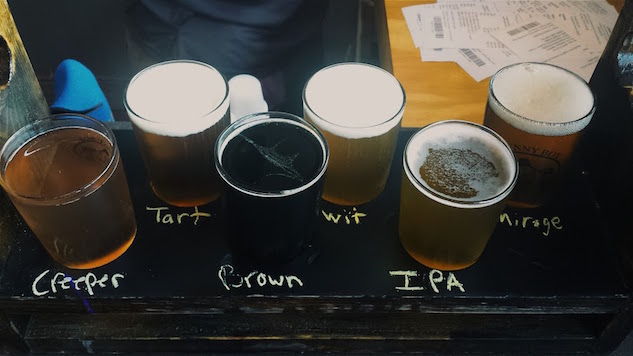Talking Frankenstein Methods and Kombucha Beer With Lenny Boy Brewing
Photo by Lenny Boy BrewingLenny Boy Brewing in Charlotte, N.C., has a facility unlike any brewery I’ve ever seen: Oak barrels lie adjacent to a panoply of cloth-covered steel tanks akin to miniature missile silos, and the room, which smells slightly of vinegar, is filled to the brim with a collection of knick-knacks and devices—beakers, basters, small mason jars also covered in cloth and filled with mysterious elixirs—that give the place the feel of a mad scientist’s laboratory.
But the setting makes sense: Here, a beer and brewing method unlike anything I’ve ever encountered before is coming to life like Frankenstein’s monster, spurned by the “fermentation relationship” of Lenny Boy owner Townes Mozer and his head brewer, John Watkins.
“We had a little wort from our brown ale left over, and me and John were messing around and pitched in some of our kombucha culture to see what would happen,” said Mozer, who caught the “fermentation bug” in college and has continually brewed kombucha, wine, beer and mead in the eight years since.
What happened in their experiment is that the kombucha culture “went wild,” turning what was technically un-hopped malt tea into an über-tart sour beer using a microbial combination of symbiotic bacteria and yeasts. After trying the mouth-puckering product, Mozer and Watkins came up with the idea of blending the beverage with fresh, conventional brown ale to round it out with sweetness, then barrel-fermented brown ale, also fermented with kombucha culture, for added nuance.
The result: a beverage reminiscent of a Belgian oud bruin that tastes of raspberry and a slight, vanilla oakiness, with an edge of nuttiness and vinegar-like acidity.
“You have a lot of different profiles going on,” said head of quality control Jason Bock of the Burn Down for What sour brown ale.
Kombucha beer is certainly not new, but the kombucha beer that Lenny Boy churns out is particularly unique because of the brewery’s method. The definition of kombucha beer is nebulous—most are either high-alcohol versions of the fermented tea or blends of kombucha and beer—and can encompass many different products. But none I’ve heard of actually take un-boiled, un-hopped wort and directly use kombucha culture to ferment it.
-

-

-

-

-

-

-

-

-

-

-

-

-

-

-

-

-

-

-

-

-

-

-

-

-

-

-

-

-

-

-

-

-

-

-

-

-

-

-

-









































